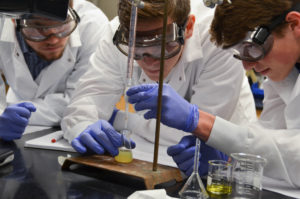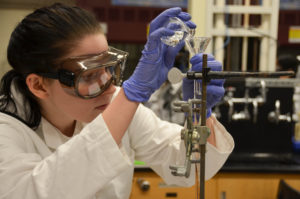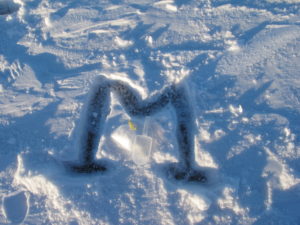
Student Alicia Kevelin selects snow samples in the Arctic (Alaska photos by Nathaniel May).
In the basement of the University of Michigan Chemistry building, students are hunched over their experiments with snow samples collected from the Arctic, interpreting impacts of climate change and sea ice loss.
“Why are our results turning out like this?” a student asks, pointing to a beaker.
“Well, where’s your sample from?” teaching assistant Claire Mattson asked, a few seconds later answering her own question. “It was taken from further down and possibly touched the sea ice, making it saltier.”

Lab photos by Suzanne Tainter, Michigan Chemistry
Assistant Professor of Chemistry Kerri Pratt’s lab section is one of several Authentic Research Connection courses at the university, which aim to give students hands-on opportunities to see how real science is conducted, as opposed to cookbook experiments, in which students go through lab exercises without thinking about how the science actually happens.
“Students are often focused on getting the ‘right’ answer in lab,” said Jeffrey Spencer, a graduate student instructor for the class. “But in this lab, there aren’t right answers. It’s about conducting tests and figuring out why you’re getting the results that you got.”
Students still learn general chemistry concepts as they check pH and chloride levels on real Arctic snow samples collected by former students. The snow chemistry results may reflect open water nearby, which can signal sea ice loss.

“I went through an early research experience in my first year of college, and it made a huge difference to me and changed my major,” Pratt said. “Incorporating research in the classroom is something I’m passionate about, especially because of my experience in college.”
Because of that career-shaping experience, Pratt decided to design a course that would help retain students in the STEM field by showing them what actual research looks like. After being asked to be part of a Howard Hughes Medical Institute grant, Pratt was able to offer the first section of the class in the fall semester of 2015.
Mattson, a senior who took Pratt’s class the first time it was offered during her freshman year, now works in Pratt’s lab conducting research and is a teaching assistant for the course.
“I think this course opens students up to other career paths,” Mattson said. “When I was a freshman, I thought the only options in the sciences were to go into engineering or become a doctor. It’s interesting to see that there’s so much you can do within the STEM world that isn’t either of those two things. Real world research doesn’t have to be just sitting in a lab mixing chemicals and looking at a computer all day. You can have some amazing experiences.”

Taking the course opened up the opportunity for Mattson to travel to Utqiaġvik, Alaska, with Pratt to collect snow samples for future lab sections. The students’ travel was made possible by the Program in International and Comparative Studies though the Arctic Internship Fellowship.
“The town took almost 24 hours to get to since it’s at the northernmost point of the United States,” Mattson said. “We got to take snow machines out onto the sea ice. I got to see the northern lights, and even a polar bear and caribou.”
Students ask questions they’d like to find out about Arctic snow chemistry, and their labs help them get the answers. At the end of the semester, they write a research paper and present at a poster symposium.
“The students have unique viewpoints for approaching the data, and we allow their creativity to take over. Occasionally this sparks an idea for my research group to pursue further,” Pratt said.
“As an undergraduate engineering student, I wouldn’t normally get the chance to do research,” said Ana Beyer, an instructional aide for Chem 125/6 and a former student of the class. “But being exposed to a research-based lab section was a really good experience, and it urged me to pursue research in my sophomore year.”
Nathan Peterson, a junior who took Pratt’s course his freshman year, is now an instructional aide.He noted how working as an instructional aide let him see how much work goes into creating an authentic research experience.
“The course has evolved so much in the two years,” Peterson said. “I’ve really seen it grow, and though it’s still developing, I’ve seen that it can accomplish a lot.”


